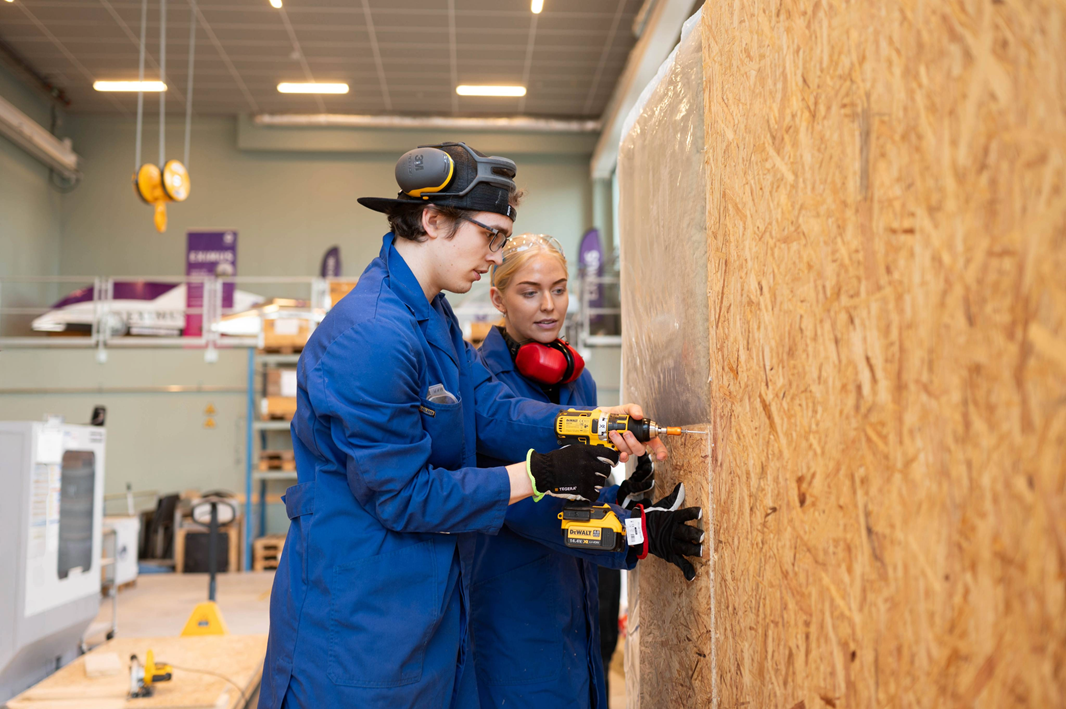This news item was published more than six months ago and may no longer be relevant.

The sustainability experiment with its Ice Box Challenge competition sets a clear question: What difference can sustainable and energy-efficient construction make to traditional construction?
Since November, Dalarna University construction students from several programmes and educational levels have put their theoretical knowledge into practice to find out.
With drawings, saws, screwdrivers and lots of enthusiasm, the students have together built two small houses in the university's technology lab at Campus Borlänge. One house has been built according to Swedish energy requirements; the other, meanwhile, has been built according to passive house principles, with a focus on maximum energy efficiency and minimal climate impact.

Two small houses have been erected in the Ovanbro carpark beside Campus Borlänge, each with a ton of ice inside. Now the experiment starts: which house can hold the ice the longest in the spring heat?
In recent days, the houses were completed and installed at the Ovanbro carpark at Campus Borlänge. On Thursday, a block of ice weighing one ton was placed into each house. Now the question remains: which of the two houses can preserve the most ice for a whole month outside in the spring-summer heat?
Master's student Mascha Drogt, who is in the Master Programme in Energy Efficient Built Environment at Dalarna University, led the work to design the two houses in the Ice Box Challenge. As team leader, she has coordinated students from different nationalities, organised materials from local suppliers and carried out calculations to ensure that the energy-efficient house meets passive house standards:
– It has been challenging to combine municipal requirements with the size of the ice block and passive house standards in the design process, but it has also been incredibly educational, says Mascha.
Mascha Drogt has been the team leader for the design work of the houses.
The university is competing against other students who are located in different climate zones, from Växjö in the south to Luleå in the north, who have all designed and built their own small houses. But winning is not just about which university manages to keep the most ice. It is the complete perspective on sustainability that has the most bearing, and the focus here is on smart, climate-friendly material choices.
– I hope that our choice of materials can inspire sustainable construction! For example, we have used the wool from sheep in Mora to insulate and recycled newspaper pulp from Älvdalen and we have built the facade with wood from an old skate park in Borlänge, explains Masha.


The houses under construction in the large technology lab at Campus Borlänge.
Civil engineering student Daniel Persson has been responsible for the construction and designed the houses that are now on display in Borlänge. For him, the project has become a way of translating the theory of education into practical construction:
– Previously, I had no experience in construction; now, though, I did the drawings we built from. Without the theoretical skills I acquired during my years in construction technology, I wouldn’t have been able to do anything. I would have just assumed what a good rule is. Now I have been able to calculate what a good rule is. The competition has required lots of work – it was almost equal to an extra course. But it has been fun, educational and challenging, definitely worth being a part of!
Passers-by at Campus Borlänge can follow the melting of the ice blocks through the windows of the houses until the National Day on 6 June. At that point, the houses will be opened and the results revealed: how much ice is left, and which building best withstood the heat?
The competition will conclude with an award ceremony in Stockholm, where an international jury will announce which of the houses is the most sustainable.
Facts about the Ice Box Challenge
- Will take place in some 17 cities worldwide.
- Combines theory and practice on the subject of sustainable development.
- Integrates five of the UN’s Sustainable Development Goals.
- Visualises the impact of energy-efficient construction on the climate.